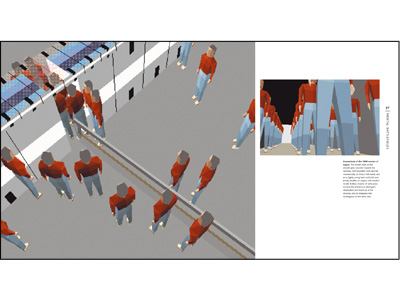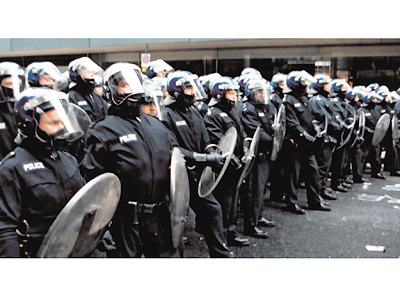Home
---------------------
Me, Myself & I:
The Big Idea
Resume | CV
Press Coverage
Press Pack
Give Feedback
---------------------
Projects:
Emotional Cartography
Brentford Biopsy
Strange Weather
Mapping Change
Stockport Map
Sensory Deprivation
SanFran Mapping
Network Identity
Mapping Fulham
Affect Browser
CCTV Rap
PhD Concept
RFID Map
Bio Mapping
Emotion Map
Mobile Vulgus
Legible Mob
Crowd Compiler
Community Edit
Rio - Point of Sale
Fuel Air
--------------------
Links
--------------------
Group Hub
Webmail

Mobile Vulgus
Christian Nold
2001
This book emerged out of one year of research and interviews with riot police, non-lethal weapon designers as well as activists and sociologists over the period of one year.
How can we come to new conceptual understandings of the behaviour of all the protagonists involved in political demonstrations?
How do people group together? And what are the methods of containment used in order to regulate the 'vulgar mob'? These are just two of the questions elicited by Christian Nold in Mobile Vulgus . Looking at the tactics used by state forces, in particular, non-lethal weapons and associated training regimes, he traces the move toward total policing.
Positioning itself within the counter-tendencies the book then develops its own methodologies of action. Once aligned under a common desire this project reveals the potential force a crowd of people hold when they act as a cohesive whole. At once a textual treatise, a visual manual and an audio tool, Mobile Vulgus has developed out of in-depth research, alongside test situations in Bristol and London.
ISBN 1 870699 56 4 - Price £7.50

Spread showing what the Britishpolice call "RealityTraining" where groups of police practice throwing Molotov Cocktails at each other within the confines of a simulated housing estate.

Architectural computer model designed to simulate the passage of people through confined spaces. In this example the simulation suggest that people would move faster through doorways if we build concrete barriers for them to line up against.
 The modern horns of Jericho.
The modern horns of Jericho.
How to bring down the walls of the Empire.
Sharp Talk
Dario Azzellini on Mobile Vulgus by Christian Nold
You are on a legal demonstration, which is supposed to be your right in the wannabee democracies of the western hemisphere, but suddenly the police force surrounds you and just keeps you there immobilized for hours. They don't do you any harm as such (apart from filling up their x-files with even more information, pictures, fingerprints and perhaps also genetic prints of alleged subversives), except to prevent you from doing anything, - mainly from your right to demonstrate. Being trapped by police is no fun, it's also illegal, but who cares, police and authorities sure don't, nor do the courts. This tactic, widespread throughout Germany (West not East) for the past twenty years, has crossed many borders and seas. Christian Nold, the author of Mobile Vulgus, has had his personal experience with this particular type of internment on Mayday 2000 and 2001 in London. Held for eight hours along with four hundred other demonstrators in Oxford Street, London, assaulted with teargas as a "preventive action," Christian Nold is not a neutral observer anymore - even if it were ever possible for such a notion to exist and even if he wanted to be one. He writes: "I had been thrown into the middle of a controlled battle which revolved around rules that I did not understand…feeling a huge solidarity with the people I met and witnessing the unreported police violence against them my position became polarised."
This is an exciting, frightening and sometimes astonishing book. It's a laurel crown for the mob, shifting away from the hysteric and mindless picture drawn of masses by the ruling classes, repositioning them instead as a concrete and collective 'experience' empowering the individual, building a force for change. Having described this context, it's superfluous for Nold to describe the central question that every professional politician, sociologist or journalist would raise: "What does the crowd want?"
Sticks and stones have for centuries been the arms of the unarmed, used to oppose landlords and governments, armies and injustice. Even today, in some countries the way to break up demonstrations and discourage protesters is still to shoot at them, but in most of our so-called democracies methods of dispersal are much more sophisticated. However Janet Morris, a pioneer developer of non-lethal weapons suggests that, "when a boy with a rock faces a high tech army, that boy will win … unless you can be less lethal than that rock." So, to address with issue, police and military experts, investigators and psychologists have spent time and money during the last few decades to design non-lethal weapons and techniques of crowd control. Military and police functions have got confused, armies are confronted with civilians (war is always more focused on civilians then the army wants us to believe), but with current massive media presence, this coverage of civilians has become more visible in turn creating "crowd control" and "non-lethal weapons" into a specific strategic military mask. It's important to keep in mind that according to the Human Effects Advisory Panel, who produce guidelines for the non-lethal weapons industry, "A weapon is non-lethal if it incapacitates 98% of the population, has no effect on 1%, whilst causing permanent damage to the remaining 1% - half of whom will die". All this means that the "non-lethal" police action during the G8 summit demonstration in Geneva, 2001 could have caused up to one thousand and five hundred deaths if all of the three hundred thousand participants had been targeted. "This is what democracy looks like", to use the words of Austrian video artist Oliver Ressler.
In Mobile Vulgus, Nold investigates current research and interviews weapon developers to present us with a terrifying range of non-lethal weapons that already exist, are planned or in development. We read not only of the more commonly known weapons like tear-gas and rubber bullets but also of dozens of bio-technical, electrical, electromagnetic, holographic, marker, obscurant, optical, projectile, reactant and riot control agent weapons, as well as different operational, physiological and theoretical concepts. Compared to these monstrous products created by the wicked minds of some modern Doctor Death, Aldous Huxley's Brave New World looks like a fun fair and Terry Gilliam's Brazil is "third world" again… Today, demonstrators are being blinded or paralysed temporarily by gases and electric shocks, low frequency waves in the form of beams causing nausea, vomiting and disorientation, thick and disorienting smoke restricts eye to hand coordination. Anyone who manages to get away from all these weapons could be stained with foam or smoke dyes for identification purposes at a later date.
Fortunately the author doesn't abandon the readers to overwhelming desperation. Nold outlines different ways and means to face modern police tactics employed by such groups as the "tute bianche" in Italy, to create his own non-lethal weapon - a kind of modern horn of Jericho designed to empower the multitude to bring down the walls of the Empire. Informed by the recent closing down of London's Millennium Bridge after some small cracks appeared and reminded of the collapse of the Broughton Suspension Bridge near Manchester in 1831 under the rhythm of marching troops, Christian Nold concieves his own ingenious protester-tool aimed at causing superficial surface damage in official buildings using sound waves.
The idea is simple. Mobile Vulgus has an accompanying CD containing sixteen audio tracks (in a frequency range between 2,25 Hz and 2,85 Hz) edited from street recordings of the London Mayday 2001 demonstrations. With the help of a portable CD player, whistles, an FM transmitter, a megaphone, a helium balloon and multiple radios, it should be possible to unite a crowd and direct its energy against selected buildings and bridges. "The audio CD acts a calibration tool … it consists of five sets of loops pitched at ever increasing speeds/frequencies covering the full range of human movement. By continually jumping at the speed set by the audio loops and observing the structure, the amount of vibration should increase as the speed approaches the particular resonant frequency. When the natural frequency has been pinpointed, and if sufficient force is applied, the material will react in a very distinctive way that can be heard and/or felt."
And even if the first test event that the author staged in Bristol didn't quite bring down a building - only a highly coordinated group of people will able to manage it - it still remains a fascinating idea to jump and dance, bringing down the palaces of power…
Dario N. Azzellini is an author, journalist and translator, working in print, radio and film media. He was born in Germany in 1967 and currently lives in Berlin. He works with the Research and Documentation Centre (FDCL) and the Migration Research Centre (FFM) for Chile and Latin America and is a member of the leftist group FelS contributing to the political cultural magazine Arranca.
Mobile Vulgus by Christian Nold
How do people group together? And what are the methods of containment used in order to regulate the 'vulgar mob'? These are just two of the questions elicited by Christian Nold in Mobile Vulgus. Looking at the tactics used by state forces, in particular, non-lethal weapons and associated training regimes, he traces the move toward total policing. As such methods have developed, so on the other side protest tactics have evolved in order to counteract them. Positioning itself within the counter-tendencies the book then develops its own methodologies of action. Once aligned under a common desire this project reveals the potential force a crowd of people hold when they act as a cohesive whole. At once a textual treatise, a visual manual and an audio tool, Mobile Vulgus has developed out of in-depth research, alongside test situations in Bristol and London.
Mobile Vulgus is available for purchase from the Book Works website: www. Bookworks.org
It is published in an edition of 1,000 copies, 128 pages, printed offset, with an audio CD, 170x155mm, ISBN 1 870699 56 4, Price £7.50.
Designed by Jason Rainbird and Christian Nold
---------------------------------------------------------------------------
Christian Nold christian@softhook.com
---------------------------------------------------------------------------
All the work on the Softhook website is licensed under a Creative Commons Attribution NonCommercial ShareAlike 2.5 License unless otherwise stated on the page or in the image ALT tag. The CSS is adapted from Intensive Station
Last Updated 3/3/2011
------------------------------
It has been an enourmous long time since I last updated this! I have never been a blog person, and felt irritated by the way new media culture pushes us to be constantly visible to the world. Recently though I kept getting email from people wondering what I was up to. So today is my birthday and I have finally given in :) . So a quick update I am excited about what Rob van Kranenburg and I are calling the Internet of People - which will be a book coming out in the next few months. I am also exstatic about trying to build and map alternative currencies. Take a look at the Bijlmer Euro project. In the last year I have also been building a unique mapping software called Sensory Journeys and the Town Toolkits for which I will build a proper site. On Saturday I am off to Helsinki for the Pixeache festival where I am preseting some work but more importantly working on and island toolkit for the next year. More info soon...